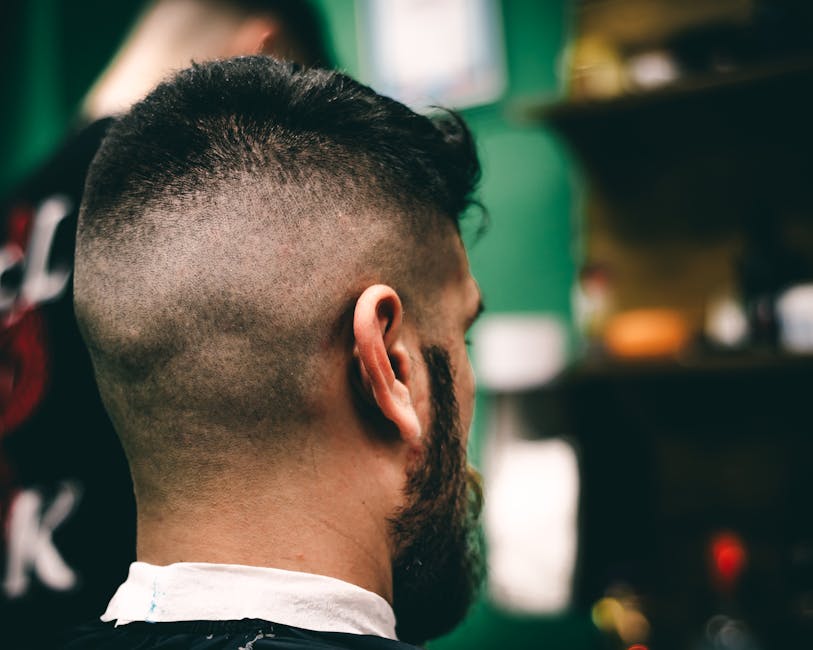The Ultimate Guide to Taper Fade Haircuts
A taper fade is a versatile men’s haircut where hair gradually shortens from the top down to the sides and back, creating a clean, blended appearance. This popular style combines the gradual transition of a taper with the seamless blending technique of a fade.
Quick Facts About Taper Fades:
- Definition: Hair transitions from longer on top to shorter on sides and back
- Popularity: Among the most requested men’s haircuts worldwide
- Maintenance: Requires touch-ups every 2-4 weeks
- Variations: Low, mid, high, skin, temple, burst, and afro taper fades
- Suitability: Works with most hair types and face shapes
The taper fade has surged in popularity over the last five years, becoming a staple in barbershops around the world. What makes this cut so sought-after is its remarkable versatility – it pairs well with virtually any hairstyle, from buzz cuts and comb overs to mullets and textured flows.
“If the hair is shorter at the bottom than on the top, it’s a taper haircut,” as barbers often explain. A fade is actually an extremely short taper where the hair blends all the way down to the skin, creating that signature “faded” effect above the natural hairline.
Many clients and barbers use the terms “taper,” “fade,” and “taper fade” interchangeably, which can lead to confusion. To avoid miscommunication, it helps to understand that a taper maintains some length throughout, while a fade typically goes down to the skin at some point.
Whether you’re looking for a clean-cut professional style or an edgy modern look, the taper fade offers endless possibilities to express your personal style while keeping maintenance relatively simple.

Taper fade definitions:
Understanding the Taper Fade Haircut
Let’s break down what makes a taper fade special before you commit to this popular style. Think of it as the perfect middle ground between classic and contemporary.
A taper is when your hair gradually changes from one length to another – typically longer on top and shorter as you move down toward the neckline. It’s that clean, graduated look that’s been a barbershop staple for generations.
A fade takes things further by cutting the hair so short at the bottom that it “disappears” into the skin. It’s like a taper on steroids, requiring precise blending skills from your barber.
The taper fade beautifully marries these concepts. You get the gradual length transition of a taper with the clean, blended aesthetic of a fade. Unlike a pure fade, a true taper fade typically retains some length throughout, only potentially touching skin at the very edges near the neckline and ears.
This style has rich cultural roots tracing back to 1980s and 1990s barbershops in Northeastern US cities, emerging alongside techniques like the “shape-up.” What began in African American, Italian American, and Hispanic American communities has evolved into a cross-cultural mainstream style acceptd worldwide.
| Feature | Taper | Fade | Undercut |
|---|---|---|---|
| Length Transition | Gradual | Very short to skin | Disconnected |
| Neckline | Natural hairline preserved | Often fades to skin | Sharp contrast |
| Maintenance | Every 3-4 weeks | Every 2-3 weeks | Every 4-6 weeks |
| Formality | Business-appropriate | Modern, edgy | Bold, trendy |
| Blending | Smooth, less dramatic | Sharp contrast possible | Intentional disconnect |
Key Benefits of a Taper Fade
The taper fade isn’t just popular because it looks good – though it absolutely does. This cut offers several practical advantages that keep people coming back:
The sharp, clean outline frames your face beautifully, often highlighting your best features while minimizing others. Its exceptional adaptability means it works with virtually any hair type – whether you’re rocking straight, wavy, curly, or coily locks.
Daily styling becomes remarkably simple with a taper fade. While you’ll need regular trims, your morning routine often requires minimal effort, especially if you keep the top relatively short. Perhaps best of all, it grows out gracefully, maintaining its shape longer than many other precise cuts – perfect for those busy weeks when you can’t make it to the barber.
The versatility factor can’t be overstated. A taper fade pairs with countless top styles, from conservative side parts to edgy textured crops, making it suitable for both the boardroom and weekend trips.
Drawbacks to Consider
Before you book that appointment, there are a few things to keep in mind about the taper fade:
Maintaining that crisp, defined look requires commitment. You’ll typically need to visit your barber every 2-4 weeks, which adds up in both time and money. And not just any barber will do – finding someone who truly understands the art of proper blending is crucial for a flawless taper fade.
If you work in a highly conservative office, very high or skin taper fades might push the envelope a bit too far (though low taper variations generally pass muster even in traditional environments). And should you decide to completely change your style later, growing out from a taper fade takes patience and likely several transitional cuts along the way.
The taper fade strikes that perfect balance between timeless and trendy – a versatile foundation that can evolve with your style preferences while keeping you looking sharp day after day.
Types of Taper Fades: Low, Mid, High & Beyond
The world of taper fades offers a variety of options to suit different preferences and face shapes. Understanding these variations will help you communicate better with your barber and choose the style that works best for you.
Low Taper Fade
The low taper fade begins just above the ears and neckline, creating a subtle gradient effect while maintaining more hair on the sides. This conservative option works well in professional settings and requires less frequent maintenance than higher fades.
Mid Taper Fade
Starting at the temples, the mid taper fade offers a balanced look—not too conservative, not too edgy. It provides more contrast than a low fade while still being versatile enough for most settings.
High Taper Fade
Beginning at or above the temples, the high taper fade creates a bold contrast between the longer top and the shorter sides. This dramatic style draws attention upward and can help elongate round face shapes.
Skin/Bald Taper Fade
This variation blends down to the skin (hence “skin fade” or “bald fade”), creating the most dramatic contrast. It can be applied to low, mid, or high positions, depending on where the fade begins.
Temple Fade
Also known as a “Brooklyn fade” or “blowout,” the temple fade focuses the tapering effect around the temples while maintaining more length at the back and sides.
Burst Fade
The burst taper fade radiates outward from behind the ear in a semi-circular pattern, rather than following the traditional horizontal line around the head. This creates a unique “burst” effect that works particularly well with mohawks and faux hawks.

Afro Taper Fade
Specifically designed for curly and coily hair textures, the afro taper fade maintains volume and natural texture on top while creating clean, tapered sides. This style celebrates natural hair while adding structure and definition.
Curly Taper Fade
Similar to the afro taper but adaptable to various curl patterns, the curly taper fade accepts natural texture while providing a clean, graduated silhouette. It’s excellent for managing thick, curly hair while showcasing its natural movement.
Design Fades
For those seeking something more unique, design fades incorporate patterns, lines, or even images shaved into the faded portion of the haircut. From simple lines to elaborate designs, these personalized touches make a taper fade truly one-of-a-kind.
Choosing the Right Taper Fade for Your Face Shape
Selecting the right taper fade variation can improve your natural features and balance your face shape:
-
Oval Faces: Considered the most versatile face shape, oval faces can pull off virtually any taper fade style. Choose based on personal preference rather than face-shape limitations.
-
Round Faces: Higher taper fades with more volume on top help elongate round faces by creating the illusion of length. Consider a high taper with a textured quiff or pompadour.
-
Square Faces: Mid taper fades complement square faces by softening strong jawlines while maintaining masculine features. A textured top with medium length works particularly well.
-
Heart Faces: Low to mid taper fades help balance wider foreheads with narrower chins. Avoid too much height on top, which can exaggerate the top-heavy appearance.
-
Diamond Faces: Low taper fades with fuller sides help balance wider cheekbones with narrower foreheads and jawlines. Some volume on top can help create proportion.
The key is to use the taper fade to create balance—adding height where needed, reducing width in other areas, and framing your face in the most flattering way possible.
Popular Styling Variations with a Taper Fade
The versatility of the taper fade means it pairs beautifully with numerous top styles:
-
Pompadour with Taper Fade: This classic style features volume and height at the front, gradually receding toward the back, complemented by tapered sides for a modern twist on a vintage look.
-
Comb-Over Taper Fade: A sophisticated option with hair combed to one side on top, creating a clean, structured appearance perfect for professional settings.
-
Textured Crop Taper Fade: Featuring a shorter top with natural texture and a fringe (optional), this low-maintenance style offers a contemporary, effortless vibe.
-
Mullet Taper Fade: The modern mullet combines the “business in front, party in back” concept with clean tapered sides for an updated take on this comeback style.
-
Slick Back Taper Fade: All hair on top is styled backward, creating a sleek, polished look that pairs perfectly with the clean sides of a taper fade.
-
Beard Fade: For those with facial hair, blending your taper fade into your beard creates a cohesive, intentional look that lifts your overall style.
Asking Your Barber & DIY Taper Fade Steps
Getting the perfect taper fade starts with clear communication. Trust me, your barber wants you to walk out happy—they just need to know exactly what you’re envisioning!
Consultation Tips
The consultation is your golden opportunity to get exactly what you want. When I sit down in the barber chair, I always make sure to be crystal clear about my expectations. Start by specifying whether you want a true taper fade or just a taper or fade—these terms might seem interchangeable, but they create different looks.
Guard numbers are your friends! Instead of saying “short on the sides,” try something like, “I’d like a low taper fade starting with a #2 at the bottom, blending to a #4 on the sides.” This precision helps your barber deliver exactly what you’re looking for.
Nothing beats a good visual reference. I always keep a folder of haircut inspiration on my phone—barbers are visual artists, and showing them a photo of your desired taper fade can eliminate confusion instantly. Just be realistic about whether that style will work with your hair type!
Don’t forget to discuss how you want the top styled. Length, texture, direction—all these details matter. And while you’re at it, mention your neckline preference (rounded, squared, or tapered) and whether you want a natural hairline or a crisp “line-up” with defined edges.
Barber terminology varies regionally. What’s called a taper fade in New York might be a “drop fade” in California. Clear communication bridges these gaps and ensures you leave the chair looking sharp.
Want more detailed advice? Check out this comprehensive guide on How to Ask for a Taper Fade.
DIY Taper Fade Step-by-Step
While I always recommend seeing a professional for the best results, sometimes you might want to touch up your taper fade at home or brave a complete DIY cut. Here’s how to approach it:

First, gather your tools. You’ll need quality hair clippers with multiple guards, a trimmer for detail work, multiple mirrors (a handheld one is essential for checking the back), a comb, scissors for the top, and a spray bottle with water to dampen hair as needed.
Start by establishing your baseline. Decide where your fade will start—low (just above the ears), mid (at the temples), or high (above the temples). Using your chosen guard (typically #0-1 for a fade effect or #1-2 for a more conservative taper), create your shortest length around the ears and neckline.
Creating transition points is where the magic happens. Move up one guard size and cut about an inch above your baseline. Continue this pattern, moving up guard sizes as you move up the head. The key is gradual progression—don’t jump from a #1 to a #4 without using #2 and #3 in between!
Blending requires a special technique. Use a flicking, upward motion at the transition points between different guard lengths. This creates that soft, seamless blend rather than harsh lines. Work systematically around your head, checking frequently for consistency.
For the finishing touches, remove the guard and use the lever on your clippers for fine-tuning. Clean up the edges around your ears and neckline with trimmers. If you want a natural look, use just the corner of your trimmer rather than the full blade.
Finally, style the top to your liking. Comb the top section and trim to your desired length with scissors. For added texture, try point-cutting (cutting into the hair at an angle) if you’re feeling confident.
Always finish with a 360-degree mirror check. Nothing’s worse than thinking you nailed it only to find an uneven patch in the back!
Common Taper Fade Mistakes to Avoid
Even experienced barbers occasionally make mistakes with taper fades—they’re technical cuts that require precision. Here are the pitfalls to watch for:
Harsh lines are the enemy of a good taper fade. Whether you’re DIYing or at the barber, the transition between lengths should be seamless, not looking like distinct “steps” up the head.
Symmetry matters enormously. An uneven blend where one side is higher or shorter than the other is immediately noticeable. Good barbers constantly step back and check their work from multiple angles.
Choosing the wrong fade height for your face shape can throw off your proportions. A high taper fade might look amazing on your friend but make your face look too round if that’s your face shape.
Many DIYers make the mistake of rushing through guard progressions. Skipping sizes (like going straight from a #1 to a #3) creates those jarring transitions that scream “home haircut.”
Over-tapering the crown creates that unfortunate “mushroom” effect where the sides are dramatically shorter than the top. A good taper fade maintains balanced proportions throughout.
Don’t forget that maintenance matters! Even the sharpest taper fade loses its definition after 2-3 weeks. Regular touch-ups keep that fresh, clean look that makes this style so appealing in the first place.
Maintenance, Products & At-Home Care
Keeping your taper fade looking sharp isn’t complicated, but it does require some consistent attention. Think of it like maintaining a great car – regular tune-ups keep everything running smoothly!
Maintenance Schedule
Most guys find that visiting their barber every 2-4 weeks keeps their taper fade looking crisp. If you’ve gone for a higher fade or skin fade, you might need to pop in a bit more frequently. My personal rule of thumb: when you start noticing the contrast fading, it’s time for a touch-up.
Essential Products

Your taper fade deserves the right supporting cast of products. Think of these as your style allies:
A quality shampoo and conditioner matched to your hair type forms your foundation – just like a great meal starts with fresh ingredients. For styling, matte clay or paste gives textured styles that perfect “I woke up like this” hold without the shine, while pomade is your go-to for slicker styles like pompadours and comb-overs.
For more casual, beachy vibes, sea salt spray creates natural-looking texture that doesn’t feel “done.” Guys with finer hair might appreciate hair powder for added volume at the roots, while styling cream offers lighter hold for longer tops. If you’re rocking curly or coily hair, some edge control helps maintain those clean lines that make a taper fade pop.
At-Home Touch-Ups
Between barber visits, a few simple maintenance moves can extend your style’s life. Carefully cleaning up your neckline and around the ears with a trimmer keeps things looking intentional rather than overgrown. If you’ve got facial hair, maintaining that seamless connection between your beard and taper fade makes a huge difference in your overall look.
Don’t be afraid to switch up your styling products as needed – what works in dry winter might not be right for humid summer days. Having options in your bathroom cabinet saves you from bad hair days.
Styling Routine for a Fresh Taper Fade
Creating a simple morning routine makes styling your taper fade quick and painless:
Start with a proper wash using lukewarm water – hot water strips away natural oils that keep your hair healthy. Gently towel-dry by patting rather than rubbing vigorously, which can create frizz that’s hard to tame later.
When blow-drying, remember this simple trick: blow against the natural fall for volume, or with the natural fall for sleeker styles. For most taper fade styles, you’ll want to focus on the longer top section.
Apply your chosen styling product to slightly damp or dry hair (check the product instructions), starting with less than you think you need – you can always add more. Work it through evenly from roots to tips, focusing on the top where most of your styling happens.
For guys with curly styles or those wanting to maintain a specific direction overnight, consider using a durag or silk pillowcase to prevent bedhead – it’s a game-changer that saves morning styling time.
Pop Culture & Social Media Trends Around Taper Fades
The taper fade has transcended basic haircut status to become a cultural phenomenon. Remember when the “Imagine if Ninja got a low taper fade” lyric went viral in 2023? The internet collectively lost its mind when gaming personality Ninja actually went through with getting the cut, spawning countless memes and reactions.
TikTok has become a showcase for barbers demonstrating their taper fade skills, with satisfying change videos regularly hitting millions of views. Celebrities like David Beckham, Ryan Gosling, and Zayn Malik have each put their own spin on the style, influencing men worldwide to try variations of the cut.
Instagram’s barber community has particularly acceptd the taper fade, with time-lapse cutting videos becoming a content category of their own. Some barbers have built entire careers around their precision fade work, gaining massive followings for their technical skill.
What’s most interesting about the taper fade is how it’s evolved from its cultural origins to become a truly universal style acceptd across communities worldwide – proving that great style transcends boundaries.
Frequently Asked Questions about Taper Fade
What is the difference between a taper fade and a regular fade?
When you’re sitting in the barber’s chair, terminology matters. A taper fade keeps some length throughout your cut, creating that gradual transition from longer on top to shorter on the sides and back. Think of it as the sophisticated cousin of the regular fade, which typically gets much more aggressive by blending down to the skin at some point.
Many guys choose a taper fade precisely because it offers that perfect middle ground – it’s clean and defined without being too dramatic. This makes it incredibly versatile for different settings, especially if you work somewhere with a more conservative dress code but still want to look current and stylish.
I like to explain it to my clients this way: if you want something that says “I care about my appearance” without screaming “look at my haircut,” the taper fade is your go-to option.
How often should I trim a taper fade?
That fresh-from-the-barber look typically lasts about 2-4 weeks with a taper fade, depending on a few personal factors. Your natural hair growth rate plays a huge role here – some guys seem to sprout hair overnight while others can stretch their cuts longer.
The type of fade you choose also affects your maintenance schedule. Higher fades and those that get very short near the bottom will show regrowth more quickly than a lower, more conservative taper. You’ll notice the clean lines start to blur as your hair grows, which is the telltale sign it’s time for a touch-up.
If you’re trying to extend time between cuts (we all have budget constraints sometimes!), focus on cleaning up just the neckline and around the ears. This quick maintenance can buy you an extra week or so before needing a full cut.
Remember though, part of what makes a taper fade look so good is that crisp definition – so regular maintenance is part of the commitment to this style.
Can I get a taper fade with curly or coily hair?
Absolutely! In fact, a taper fade can look absolutely stunning with curly and coily hair textures. The contrast between your natural texture on top and those clean, tapered sides creates a striking, well-defined silhouette that frames your face beautifully.
If you have curly or coily hair, here’s what I recommend:
Find a barber who truly understands your specific hair texture – this makes all the difference. Someone experienced with your hair type will know whether to cut your hair dry (often better for curly hair to account for shrinkage) or wet, and how to work with rather than against your natural pattern.
When discussing your cut, consider asking for a slightly longer guard at the bottom of the fade. This small adjustment accounts for shrinkage when your hair dries and helps maintain that perfect gradient effect.
The afro taper fade and curly taper fade variations were specifically designed to celebrate natural texture while providing structure. These styles have become increasingly popular as more people accept their natural hair while still wanting that clean, modern look that a well-executed fade provides.
Your curls or coils aren’t an obstacle to getting this cut – they’re an asset that can make your taper fade uniquely yours and truly stand out from the crowd.
Conclusion
The taper fade has rightfully earned its crown as one of the most requested men’s haircuts worldwide—and it’s not hard to see why. This incredibly versatile style offers something for everyone, blending classic barbering techniques with modern sensibilities to create a look that’s both timeless and fresh.
What makes the taper fade truly special is how it adapts to your personal style journey. Whether you’re leaning toward a subtle low taper that flies under the radar in corporate settings or you’re ready to make waves with a bold high skin fade, the magic lies in finding your perfect variation.
Remember these friendly takeaways as you start on your taper fade trip:
Your barber is your partner in this journey—bring those reference photos, learn a few key terms, and don’t be shy about communicating exactly what you want. The difference between a good cut and a great cut often comes down to clear communication.
Face shape matters! That high fade that looks amazing on your friend might not be your best match if you have a different face shape. Trust the process of finding what works specifically for you.
Maintenance isn’t just a suggestion—keeping that crisp, defined look that makes the taper fade so appealing. Pencil in those barber visits every 2-4 weeks if you want to maintain that fresh-cut feeling.
The right products can lift your style from good to head-turning. Experiment with different styling aids until you find your perfect match.
At The Dining Destination, we believe looking your best is part of living your best life—whether you’re exploring a new restaurant in your hometown or jetting off to experience culinary delights across the globe. While food and travel are our main passion, we understand that personal style improves every experience.
Think of your taper fade as the perfect garnish to your overall presentation—it completes the picture and adds that extra touch of intention to your appearance. Just as a thoughtfully plated dish shows care and attention to detail, so does a well-maintained haircut.
For more lifestyle guides that complement your culinary trips—from packing tips for food tourism to etiquette guides for dining around the world—explore our comprehensive resource hub at More info about resource guides.
Your perfect taper fade is waiting. All you need to do is take that first step into the barber’s chair.







